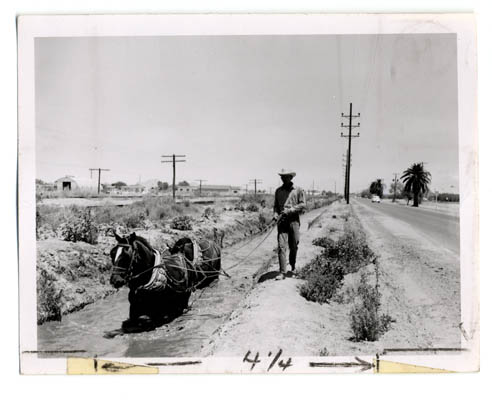Weeds and algae pose a constant challenge to the canal system in the Salt River Valley. Left to Mother Nature alone, weeds clog the canals and slow the flow of water.
 White Amur Ctenopharyngodon idella
White Amur Ctenopharyngodon idella
To help keep canals clean and clear, SRP employs the use of approximately 50,000 white amur fish – but these aren't your ordinary fish. These hearty fish eat the weeds and algae, consuming up to two-thirds of their body weight daily, and average 30 inches in length.
SRP first began experimenting with the white amur, a fish native to China, in a small stretch of the Tempe Canal in 1989.
Today, they swim throughout the entire canal system, chomping away at weeds and algae seven days a week, 365 days a year. How do you know the fish are there if you can't see them? If the canals are clear of algae and weeds, the fish are in the water and hard at work.
Read more Plant growth on the canals
Plant growth on the canals
The History
For Phoenix area residents, keeping the water flowing in the canals has always been a top priority. That means keeping the canals clean of weeds and algae.
At the turn of the century, local farmers used scythes, rakes and other crude tools to clear the weeds and algae that clogged the canals and obstructed the flow of water. As the Salt River Valley's agricultural economy grew, this became a bigger and bigger job requiring workers dedicated to keeping the canals clean.
Read moreIn their quest for labor, SRP attempted to hire local Native Americans – Apaches, Navajos and Pimas – to clean the canals by hand but still could not find enough workers.
Next, they tried to hire immigrant workers from Puerto Rico and Mexico, but strict immigration control stifled these efforts. Eventually, SRP found a ready workforce in the indigenous Yaqui village of Guadalupe just south of Tempe, Arizona. Soon the hard-working Yaqui became the backbone of the SRP workforce.
As the 20th century unfolded, SRP adopted new techniques for clearing the weeds and algae from the canal: horsepower and hi-tech machinery. The earliest method, known as disc demossing, used an arrangement of 8-inch metal discs connected by chain.
Read more Horse teams dredge a lateral
Horse teams dredge a lateral
Workers hitched the razor-sharp discs to draft horses that hauled the circular blades through the canal system's narrow laterals and irrigation ditches.
On wider canals, disc demossing required the use of two or more horse teams who together pulled a single chain covered with hundreds of discs from opposite banks of the canal.
Eventually, gas-powered tractors, road graters, and front end loaders replaced the horses, making it possible to drag even larger chains and discs through the canal system’s aquatic overgrowth.
As the vegetation broke loose, it traveled downstream where workers, many of them Yaqui Indians, removed the muck with long-handled rakes and poles.
Read more A dregder on the canal
A dregder on the canal
In the 1930s, SRP began using machines known as Ruth dredgers to clear the weeds and algae from the canals. These mechanical monsters straddled the canals, removing muck and vegetation as they crawled along at the rate of 1 mile per hour.
As the machines moved throughout the canal system, human operators scooped out debris with large buckets attached to conveyor belts. They deposited the unwanted vegetation on the canal banks, leaving a trail of waste (and stench) in their wake.
After 1950, SRP replaced the hand tools, horses and Ruth dredgers with modern equipment that was more efficient and could more easily navigate the canal banks, such as backhoes and telescoops.
The mobility of these new demossing vehicles, however, soon came to be challenged with the advent of roads, bridges and culvert construction throughout the Phoenix metropolitan area. As a result, SRP briefly used chemical herbicides to control the canal system's never-ending battle with weeds and algae.
Determined to find a more efficient and environmentally sound solution, SRP reached out to the University of Arkansas where researchers had made breakthroughs in aquatic vegetation control using a fish known as the white amur.
This innovative and biotechnical approach had roots dating back to ancient times. As early as 500 B.C., Marco Polo reported seeing white amur used to keep rice fields in Taiwan and China clean. The Egyptians also used over 45 million fish to clear weeds along the Nile River.
In 1989, SRP launched the White Amur Fish Program. Today, the program saves thousands of dollars in operating costs while promoting organic and sustainable water management practices.





